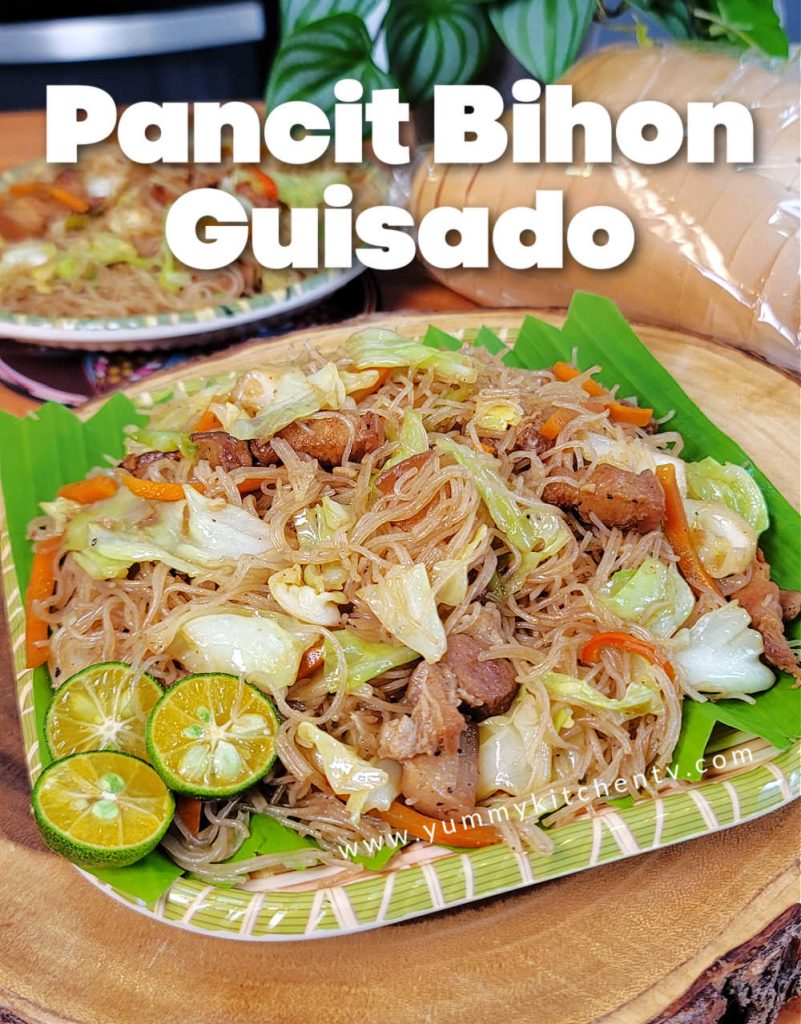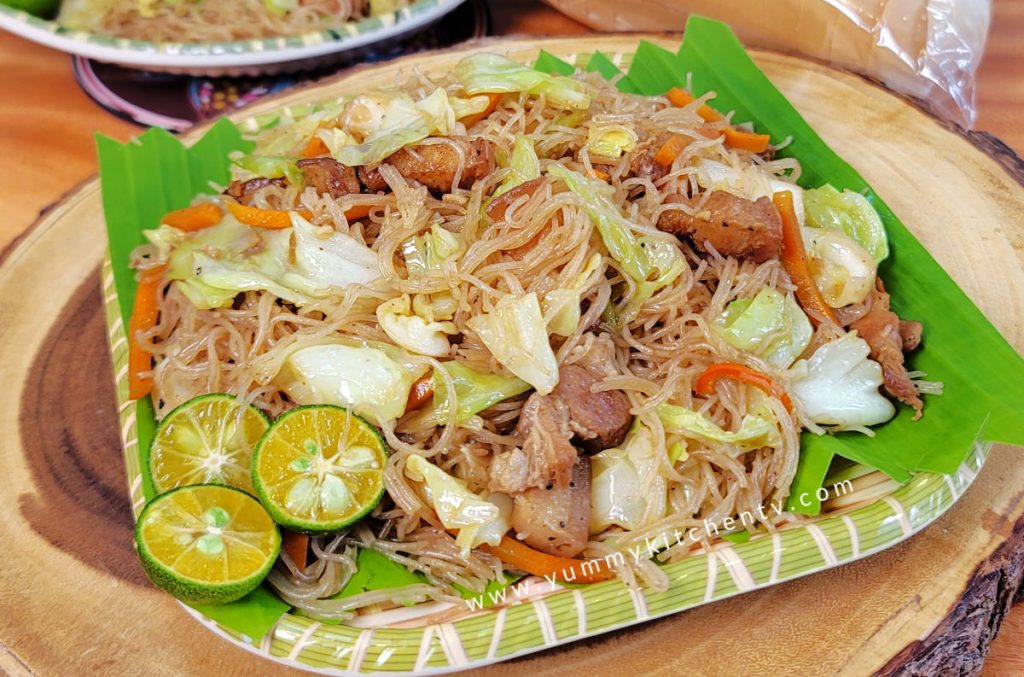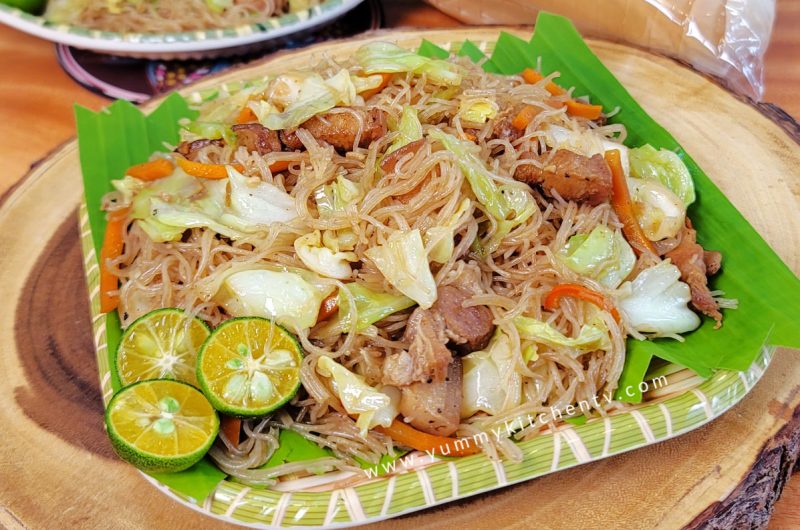Bihon Guisado: A Classic Filipino Stir-Fried Rice Noodle Delight
Bihon guisado, or sauteed rice vermicelli, is a Filipino noodle dish, made with thin hair like bihon noodles, sauteed with pork belly, carrot, cabbage in a sauce consists of garlic, onion, soy sauce, oyster sauce, shrimp broth cube, pepper and water. One reason why Pinoys love this dish is because the noodles are also made from rice (turned into rice flour). This dish is adapted from the Chinese cuisine and is now served as big cauldrons during celebrations. Pancit Bihon guisado is often enjoyed with some kalamansi and loaf bread.

BIHON GUISADO RECIPE
Ingredients:
- 500 grams bihon noodles
- 300 grams pork belly (cut into slices)
- 1 large carrot (sliced into strips)
- 1 medium head cabbage (shredded or chopped)
- 5 cloves of garlic (chopped)
- 1 medium onion (chopped)
- ¼ cup soy sauce
- 4 tablespoons oyster sauce
- 1 piece shrimp broth cube
- 1 teaspoon black pepper
- 1 medium bell pepper
- 7 – 8 cups water
Directions:
- Heat a pan (no oil). Add the pork belly slices and sear for a few minutes until light brown. Once the oil comes out, add the garlic, onions, and carrots. Saute them for 2 to 3 minutes. Season with a pepper and soy sauce. Mix well.
- Add the chopped cabbage and toss gently. Saute them for around 3 to 6 minutes until the cabbage are almost cooked.
- Add the bell pepper and mix well with the other ingredients. Once all the veggies are cooked, remove them from the pan and transfer them to a container. Set aside for a while.
- Using the same pan, add 7 to 8 cups of water and the shrimp broth cube. Season the broth with oyster sauce and more soy sauce. Cover the pot and let it boil. Once boiling, do a taste test and adjust the taste using sugar and more black pepper.
- Add the bihon noodles in the broth. As much as possible, submerge them. Unstrangle them as they cook. Wait until the broth dries up and is absorbed.
- Add the sauteed veggies back to the pan and into the noodles. Toss them together gently until the veggies are well incorporated in the noodles. Once all the ingredients come together, turn the heat off.
- Transfer the bihon guisado to a serving plate. Squeeze some fresh calamansi juice before eating. You can have this as it is or use it as a palaman to some fresh buns. Yum!
WHAT IS BIHON GUISADO?
Bihon guisado is one among the noodle dishes cooked in the Philippines. It is made from thin rice flour noodles which became translucent and soft once cooked. This noodle is very much distinguishable due to its hair-like thinness. Although the bihon noodles is sometimes interchanged with the sotanghon noodles. Since the bihon is made with rice flour and the sotanghon is made with mung bean flour, the latter feels slicker and oilier once sauteed, unlike the bihon. If you get confused on what noodles to choose in a grocery, always go for the rice vermicelli noodles.
The term “guisado” means “gisa” or “to saute” in Tagalog. In this recipe, the noodles are sauteed together with some mixed vegetables.
BIHON GUISADO
I have been trying to learn how to use chopsticks for a while and practicing it with some cornick is truly on a different level. Luckily, a neighbor of mine suddenly knocked on the our door, offering us some bihon and spaghetti while telling us that they were celebrating their kid’s 8th birthday.
Noodles is believed to lengthen the lives of the people who eats it. Did you ever notice that everytime your neighbor knocks on your door to give you some handa from their celebration, it is always bihon guisado with 3 to 5 pieces of calamansi alongside another plate of spaghetti? While there are no rules on what to give your kapitbahay, it’s always the bihon guisado that is present! Aside from being a simple dish to cook, the ingredients of bihon guisado is quite economical compare to others. Plus, you can make a large batch for just a kilo of noodles! With the noodle, meat and veggie combination, the bihon guisado can already be enjoyed as a full meal.
Practing the chopstick with bihon noodles makes the practice easier and more tolerable, plus, you’d get to eat a hearty dish!
If you wanna know how to make bihon guisado at home, read and follow the quick and easy steps below. Happy cooking!
HOW TO MAKE BIHON GUISADO
While the bihon noodles are long, the steps on how to make it is actually short and simple. Preparing some bihon guisaso is super easy, just like any other noodle recipe.
Aside from the noodles, the most important set of ingredients would be the veggie and meat toppings. Let us prepare the meat first, as we will be needing its oils to saute the other ingredients. Sear the meat by slicing them into small cuts and then cooking them in a heated oil using high heat. You don’t need to cook the pork instantly, but we want to brown the crust and wait for the savoury oil to render.
Once the oil has been rendered, use this to saute the aromatics and then the other veggies. You can choose whatever veggie you like, but the usual veggies included in a bihon guisaso are carrots and cabbage. Oftentimes, the chopseuy veggie mix from the market also works as a great veggie combination (plus, they are chopped already!). Saute the veggies and the meat. Once the toppings is ready, set them first aside.
Just like other noodle recipe, cooking the bihon noodles starts with making a broth where the noodle will cook. Of course we need to make it as savoury as possible to let the noodles sip in the flavors. In this recipe, I used a shrimp broth cube, oyster sauce and soy sauce. Feel free to add whatever seasoning you like.
Add the noodles. At first, you will be needing to untangle them by separating the strands as much as possible. As the noodles cook, the broth will dry up. The last thing to do is to add the veggies back in the noodles and toss them up! (Or, you can just add the veggies as toppings).
The best part of eating bihon guisado is drizzling some freshly squeezed calamansi juice and a slice of load bread or buns. Yum!
Pancit Bihon Guisado Recipe Tagalog

Mga Sangkap:
- 500 grams bihon noodles
- 300 grams liempo (hiniwa)
- 1 malaking carrot (hiniwa ng strips)
- 1 repolyo (hiniwa)
- 5 butil ng bawang (hiniwa)
- 1 sibuyas (hiniwa)
- ¼ tasang toyo
- 4 kutsarang oyster sauce
- 1 pirasong shrimp broth cube
- 1 kutsaritang paminta
- 1 bell pepper
- 7 – 8 tasang tubig
Paano Lutuin:
- Magpainit ng kawali (walang mantika). Ilagay ang baboy at lutuin ang mga ito hanggang maging brown at magmantika. Gamitin ang pinagmantikaan nito para igisa ang sibuyas, bawang at carrots. Timplahan ito ng konting paminta at toyo. Haluin ng mabuti.
- Ilagay ang repolyo at haluin ng dahan dahan. Igisa ang mga ito ng 3 – 6 minuto hanggang halos lumambot na ang mga ito.
- Ilagay ang mga bell pepper at igisa kasama ang iba pang gulay. Kapag luto na, alisin muna ang mga ito sa kawali at ilipat ng lalagyan. Isantabi.
- Gamit ang parehong kawali, lagyan ito ng 7 – 8 tasa ng tubig. Ilagay na rin ang shrimp broth cube at timplahan ng oyster sauce at toyo. Takpan ang kawali at hayaan itong kumulo. Kapag kumukulo na, tikman ito at timplahan ng asukal at marami pang paminta.
- Ilagay ang bihon sa kawali at ilubog ito sa sabaw. Paghiwahiwalayin ang noodles habang niluluto. Hayaan itong maluto hanggang matuyo ang sabaw.
- Ibalik ang ginisang gulay sa kawali at ihalo sa bihon. Patayin ang apoy.
- Ilipat ang bihon guisado sa serving plate. Pigaan ito ng konting kalamansi bago ihain. Kainin ito bilang meryenda at pwede ring samahan ng tinapay. Yum!






